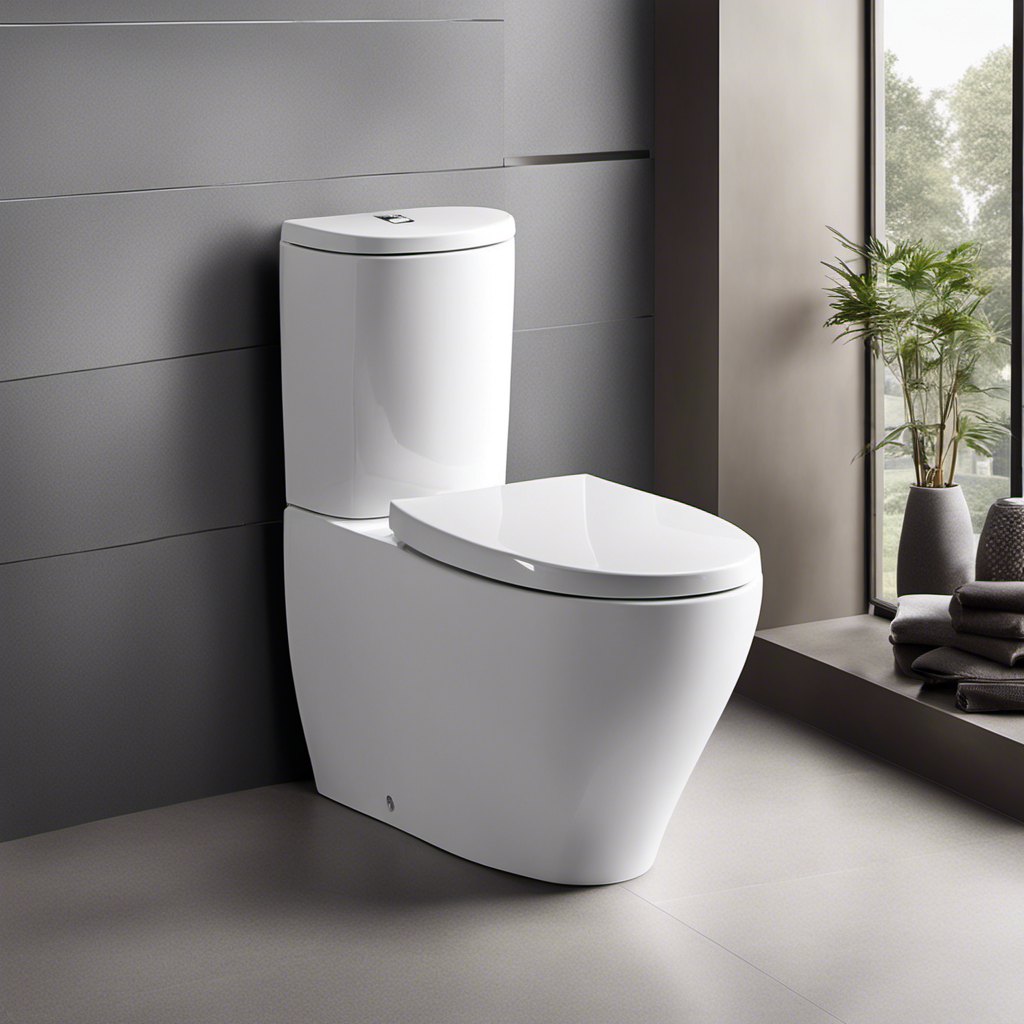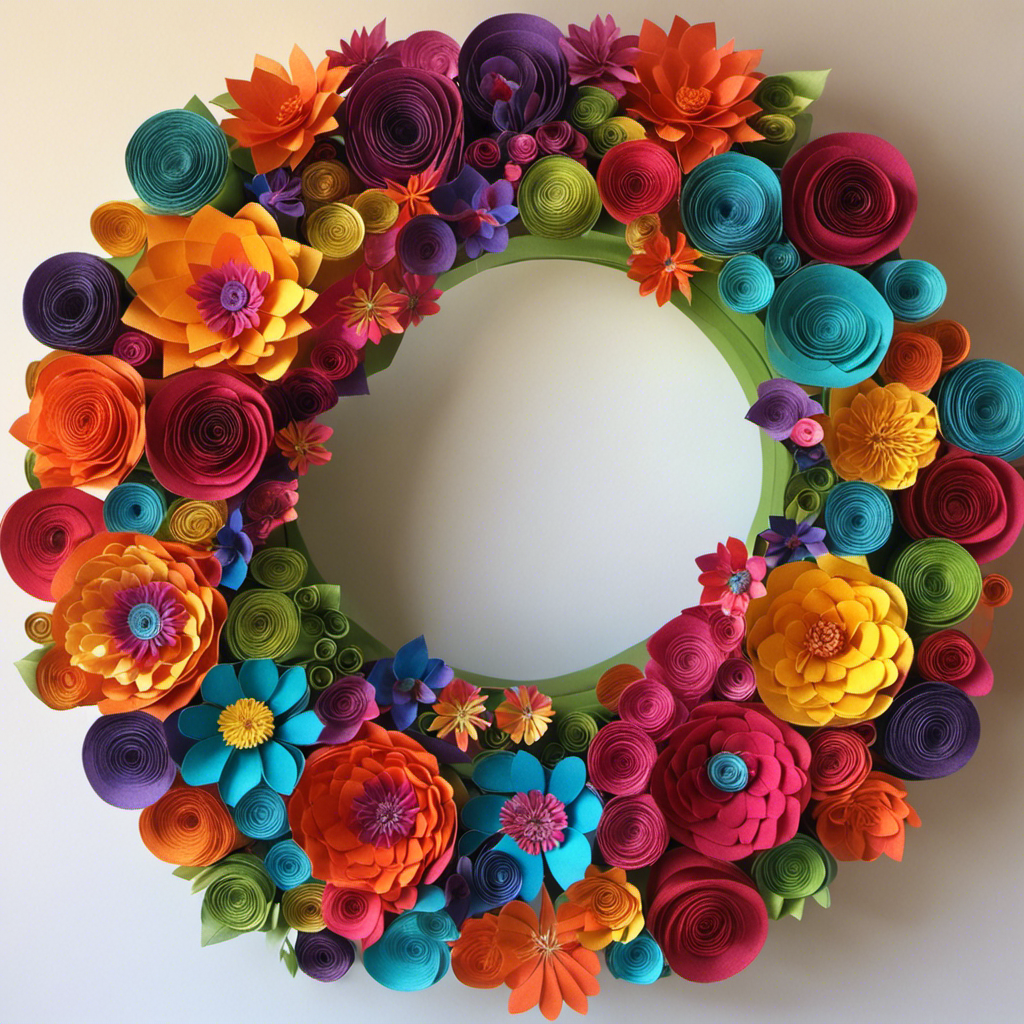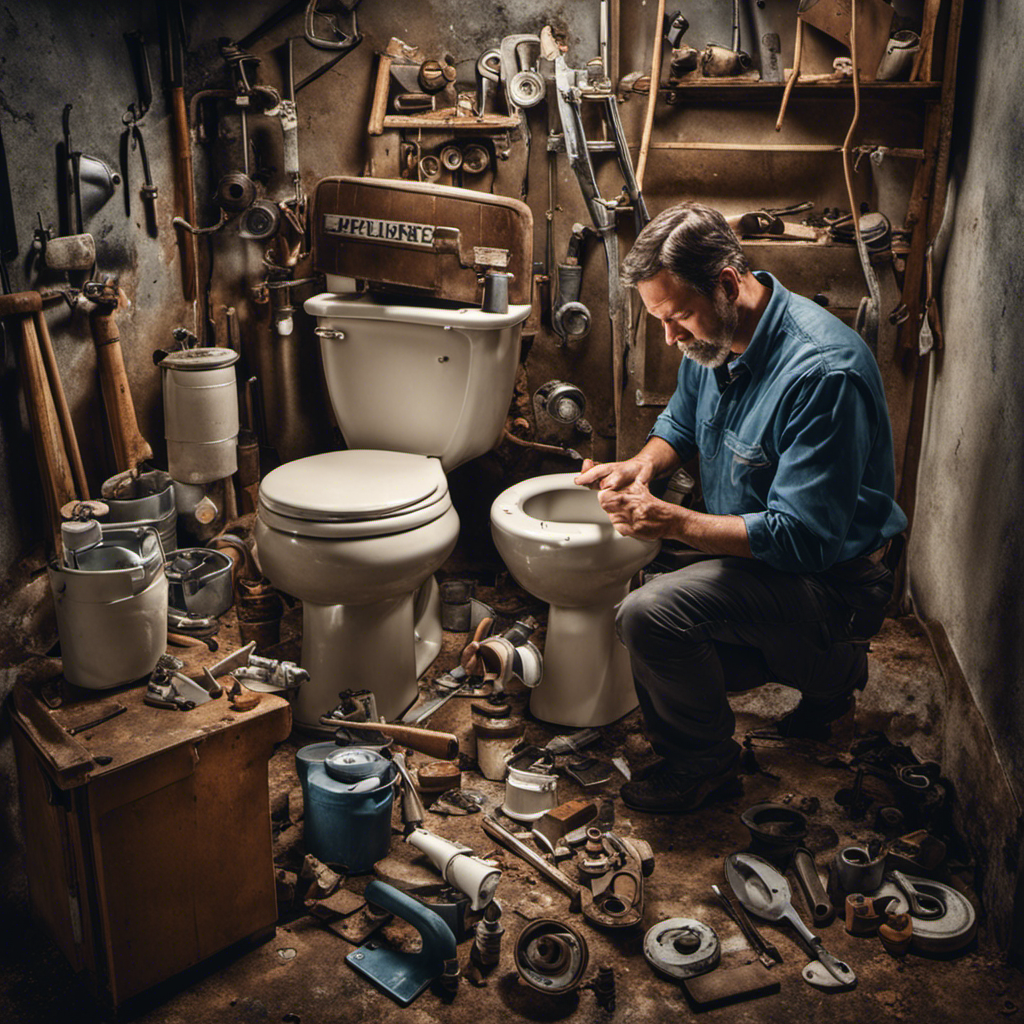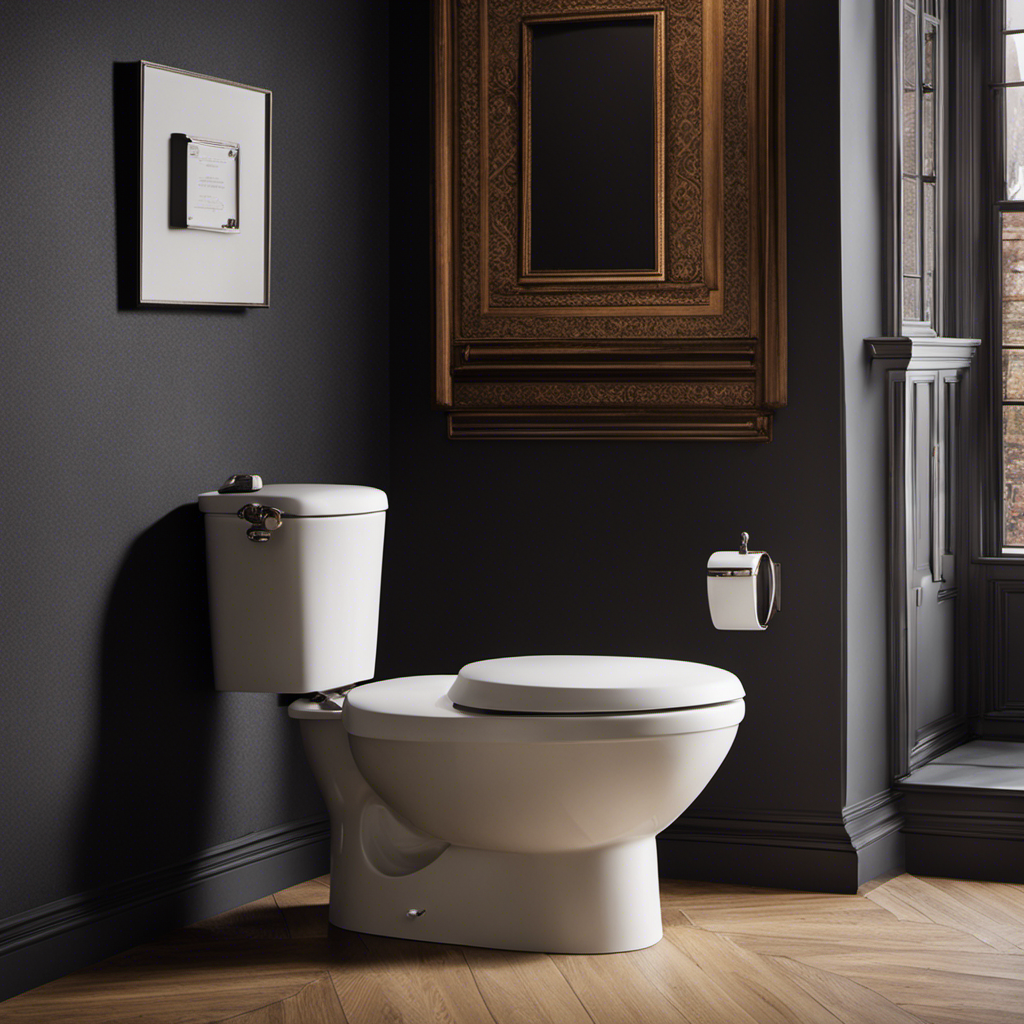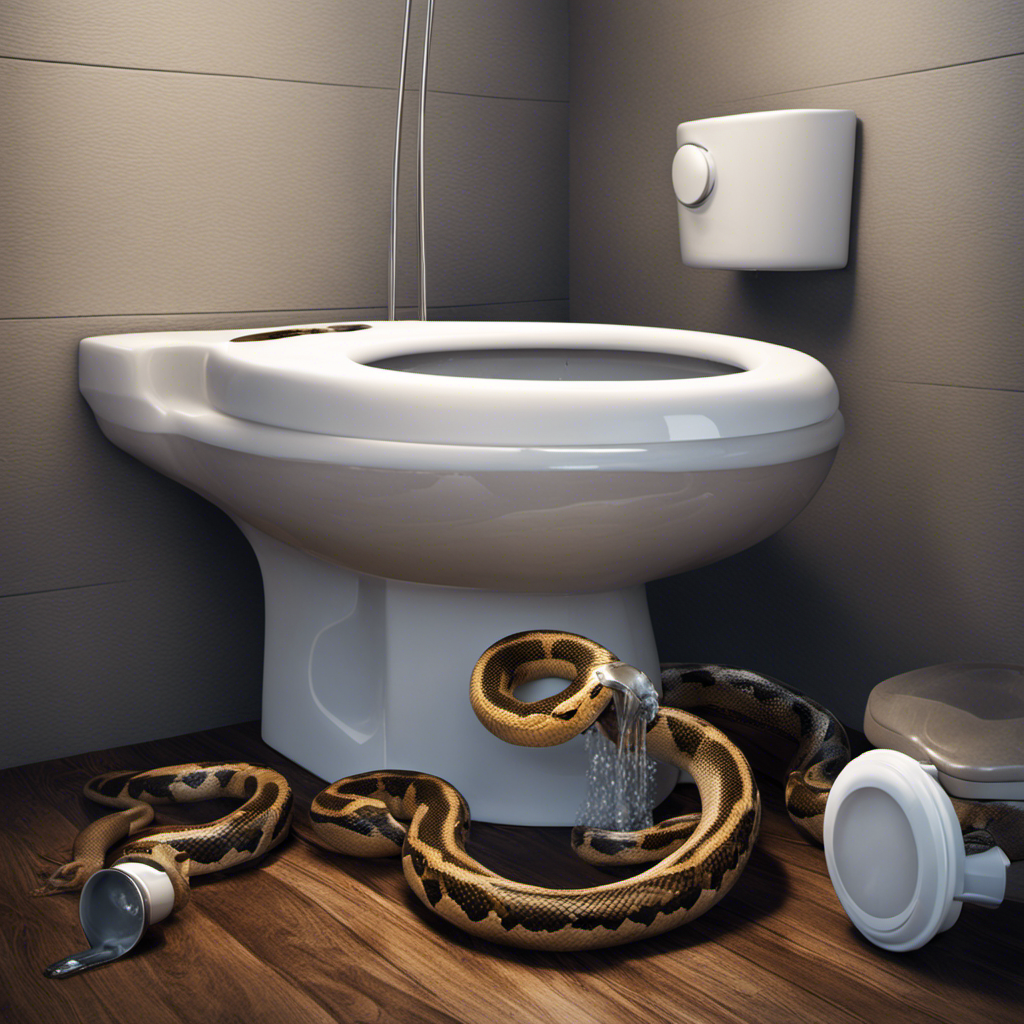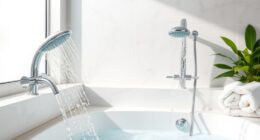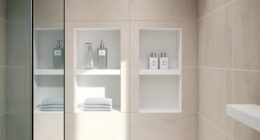When it comes to finding the perfect toilet, it’s like searching for the needle in a haystack. But fear not, because I’m here to guide you through the labyrinth of options.
In this article, I’ll walk you through the key features to look for in a toilet. From size and dimension considerations to water efficiency and maintenance requirements, we’ll cover it all.
So sit back, relax, and let’s flush out the details on what makes a toilet truly top-notch.
Key Takeaways
- Consider the size and dimensions of the space where the toilet will be installed.
- Choose a toilet seat size based on personal preference and available space.
- Different flushing mechanisms offer varying water pressure and maintenance requirements.
- Low flow toilets use less water per flush compared to traditional toilets.
Size and Dimension Considerations
When choosing a toilet, it’s important to consider the size and dimensions of the space where it will be installed. This ensures that the toilet fits properly and allows for comfortable use.
One aspect to consider is the toilet seat options. There are various types of toilet seats available, such as standard, elongated, and compact seats. The seat size should be chosen based on personal preference and the available space.
Additionally, it’s crucial to understand the installation requirements of the toilet. This includes knowing the rough-in distance, which is the distance from the wall to the center of the toilet flange. It’s also important to consider the height and width of the toilet, especially if accessibility is a concern.
Taking these factors into account will help ensure that the toilet fits perfectly in the designated space.
Flushing Mechanism Options
You should consider opting for a toilet with different flushing mechanism options. When choosing a toilet, it’s important to think about your specific needs and preferences. The flushing mechanism plays a crucial role in the toilet’s performance and efficiency. Different flushing mechanisms offer varying levels of water pressure and maintenance requirements. To help you make an informed decision, I have created the table below to compare the common flushing mechanisms available in toilets:
| Flushing Mechanism | Water Pressure | Maintenance Requirements |
|---|---|---|
| Gravity Flush | Moderate | Low |
| Pressure-Assisted | High | Moderate |
| Dual Flush | Variable | Low to Moderate |
| Power Flush | High | Moderate to High |
| Vacuum-Assisted | High | Moderate |
As you can see, each flushing mechanism has its own advantages and considerations when it comes to water pressure and maintenance requirements. Now let’s move on to discuss the water efficiency and conservation features of toilets.
Water Efficiency and Conservation Features
When it comes to water efficiency and conservation in toilets, there are several key points to consider.
One of these is the use of low flow toilets, which are designed to use less water per flush compared to traditional toilets.
Another option to consider is dual flush toilets, which give users the choice between a full flush for solid waste and a reduced flush for liquid waste.
Additionally, there are various water-saving technologies available, such as pressure-assisted flushing or gravity-assisted flushing, which can further help to conserve water while still maintaining effective flushing performance.
Low Flow Toilets
To save water, consider installing a low flow toilet in your bathroom. Low flow toilets are designed to use significantly less water compared to traditional toilets. While traditional toilets can use up to 3.5 gallons of water per flush, low flow toilets typically use around 1.6 gallons or less. This water-saving feature can lead to significant benefits, such as reducing water consumption and lowering water bills.
Additionally, low flow toilets help conserve water resources and contribute to a more sustainable environment. With advancements in technology, low flow toilets now offer improved flushing power and efficiency, ensuring that they are just as effective as their traditional counterparts.
Now, let’s explore another water-saving option: the dual flush toilets.
Dual Flush Options
With dual flush options, you can choose between a lower or higher water volume for flushing, allowing for greater water conservation. Dual flush technology offers various benefits and features that make it an excellent choice for eco-conscious individuals. Consider the following advantages:
-
Versatility: Dual flush toilets provide two flushing options, typically a half flush for liquid waste and a full flush for solid waste. This flexibility allows you to use only the necessary amount of water for each flush, resulting in significant water savings.
-
Efficiency: By using less water per flush, dual flush toilets help reduce water consumption, resulting in lower water bills and a smaller environmental footprint.
-
Customization: Some dual flush toilets even offer adjustable flush volumes, allowing you to further tailor your water usage according to your needs.
-
Sustainability: Embracing dual flush technology contributes to the conservation of our planet’s precious water resources.
Water-Saving Technology
You can easily reduce your water consumption by embracing water-saving technology.
When it comes to choosing a toilet with water-saving features, there are a few size and dimension considerations to keep in mind.
Firstly, the toilet’s overall size should fit your bathroom space. Measure the available area to ensure a proper fit.
Additionally, consider the dimensions of the toilet bowl and tank. A compact toilet with a smaller bowl and tank can be a great space-saving option.
Another important consideration is the flush volume. Look for toilets with low flush volume options, such as dual flush or gravity-assisted flush systems, which use less water per flush.
Material and Durability Factors
When choosing a toilet, consider the material and durability factors, as they will impact its longevity. The toilet bowl material plays a crucial role in its performance and maintenance. Opt for materials like porcelain or vitreous china, as they are durable, resistant to stains, and easy to clean.
Additionally, the toilet tank durability is equally important. Look for tanks made of high-quality materials like ceramic or durable plastic, as they are less likely to crack or leak over time. Investing in a toilet with reliable materials ensures that it will withstand daily use and remain in excellent condition for years to come.
Now, let’s move on to the next section, where we will discuss comfort and ergonomic design features.
Comfort and Ergonomic Design Features
When considering comfort and ergonomic design features in a toilet, there are several key points to focus on.
First, the seat shape and size play a crucial role in providing a comfortable sitting experience.
Adjustable water pressure is another important factor to consider, as it allows for personalized cleaning and hygiene.
Additionally, the height and accessibility of the toilet are essential for individuals with mobility issues, ensuring ease of use and preventing strain or discomfort.
Seat Shape and Size
If you’re looking for a comfortable toilet seat, consider the shape and size that best suits your needs. The right seat shape and size can make a significant difference in your overall comfort and experience while using the toilet.
Here are some key factors to consider:
-
Contoured shape: A contoured seat provides better support and helps prevent discomfort during long periods of sitting.
-
Elongated vs. round: Elongated seats are generally more comfortable for most adults as they offer more surface area and legroom.
-
Adjustable hinges: Opt for a seat with adjustable hinges, allowing you to customize the angle and position of the seat for maximum comfort.
-
Soft-close feature: A soft-close lid ensures that the seat and lid close gently and quietly, eliminating the risk of accidents and providing a peaceful experience.
When choosing a toilet seat, don’t overlook the importance of shape and size. Consider these factors to find the perfect seat that meets your comfort needs.
Adjustable Water Pressure
Now let’s talk about the importance of adjustable water pressure in a toilet. Having the ability to control the water pressure is crucial for a comfortable and efficient experience. Adjustable pressure settings allow you to customize the strength of the water flow to your liking.
To help you understand the significance of this feature, let me provide you with a comparison table:
| Water Pressure Setting | Description | Benefits |
|---|---|---|
| Low Pressure | Gentle and soft water flow | Ideal for sensitive individuals |
| Medium Pressure | Balanced water flow | Suitable for most users |
| High Pressure | Strong and powerful water flow | Effective for thorough cleaning |
Height and Accessibility
To ensure maximum comfort and accessibility, it’s important to consider the height of the toilet you choose. The right height can make a significant difference, especially for individuals with mobility issues or disabilities.
Here are some key considerations when looking for a toilet that offers adjustable height and grab bars:
-
Comfort: A toilet with adjustable height allows you to find the perfect position for sitting or standing, ensuring a comfortable experience every time.
-
Accessibility: An adjustable height toilet can accommodate people of different heights and abilities, making it easier for everyone to use.
-
Safety: The inclusion of grab bars provides additional support and stability, reducing the risk of falls and accidents.
-
Versatility: With an adjustable height toilet, you can easily adapt the seat to different users or situations, making it a versatile choice for any household.
Accessibility and Special Needs Considerations
When choosing a toilet, it’s important to consider accessibility and special needs.
For individuals with mobility challenges or special requirements, bathroom accessibility is crucial. Special needs toilets are designed to provide greater comfort and support, making them ideal for those with physical disabilities or elderly individuals. These toilets often have higher seat heights to aid in sitting and standing, as well as grab bars for added stability. Some models even offer adjustable seat heights and bidet features for added convenience.
It is essential to assess the specific needs of the user and select a toilet that meets those requirements.
Considering the importance of accessibility and special needs, it’s also vital to understand the maintenance and cleaning requirements of the chosen toilet to ensure proper hygiene and functionality.
Maintenance and Cleaning Requirements
Regular cleaning and maintenance are essential to keep your chosen toilet hygienic and fully functional. Neglecting these tasks can lead to unpleasant odors, clogged pipes, and potential health hazards. Here are some key maintenance and cleaning requirements to consider:
-
Regular cleaning: It is crucial to clean your toilet bowl, seat, and surrounding areas at least once a week using a mild cleaner or disinfectant. This helps prevent the buildup of bacteria and keeps the toilet looking fresh.
-
Checking for leaks: Regularly inspect the toilet for any signs of leaks, such as water pooling around the base or a continuous running sound. Addressing leaks promptly can prevent water damage and conserve water.
-
Proper installation: Ensure that the toilet is installed correctly to avoid future plumbing issues. Improper installation can lead to leaks, cracks, and an unstable toilet.
-
Maintaining the flushing mechanism: Regularly check and maintain the flushing mechanism, including the flapper, handle, and valve. This helps ensure proper flushing and prevents water wastage.
Frequently Asked Questions
Are Bidet Features Available in Toilets With Water Efficiency and Conservation Features?
Bidet compatibility and water-saving options are key features to consider when looking for a toilet. It’s important to find a toilet that offers both bidet functionality and efficient water usage to ensure a convenient and environmentally friendly bathroom experience.
What Are Some Common Materials Used in Toilet Construction for Durability?
Toilet materials vary for durability. Options include porcelain, ceramic, and vitreous china. Porcelain is like a sturdy fortress, while ceramic is akin to a reliable shield. Vitreous china, on the other hand, offers a combination of strength and elegance.
Can You Recommend Any Toilet Models That Are Specifically Designed for Individuals With Mobility Impairments?
I recommend toilet models designed for individuals with mobility impairments, such as toilets with raised seats, grab bars, and easy-flush mechanisms. These specialized toilets provide increased accessibility and safety for the elderly and disabled.
How Often Should I Clean My Toilet to Maintain Optimal Performance?
To maintain optimal performance, I clean my toilet once a week. I find that using bleach-based cleaners or vinegar and baking soda mixtures work best. Regular cleaning prevents buildup and keeps everything running smoothly.
Do All Toilets With a Comfortable and Ergonomic Design Have a High Price Tag?
Comfortable and ergonomic toilet designs don’t always come with a high price tag. There are affordable toilet options available that offer both comfort and functionality. It’s important to explore different toilet design options to find the best fit for your needs.
Conclusion
In conclusion, when it comes to choosing the perfect toilet, size does matter. Consider the dimensions of your bathroom and ensure the toilet fits comfortably.
Don’t forget to look for a reliable flushing mechanism that won’t leave you in the lurch. Opt for water-efficient toilets that help conserve our precious resources.
Additionally, prioritize durability and choose a toilet made from high-quality materials.
Lastly, don’t overlook the importance of comfort and accessibility features. Remember, finding the right toilet is not just a drop in the bucket, it’s a game-changer for your bathroom experience.
